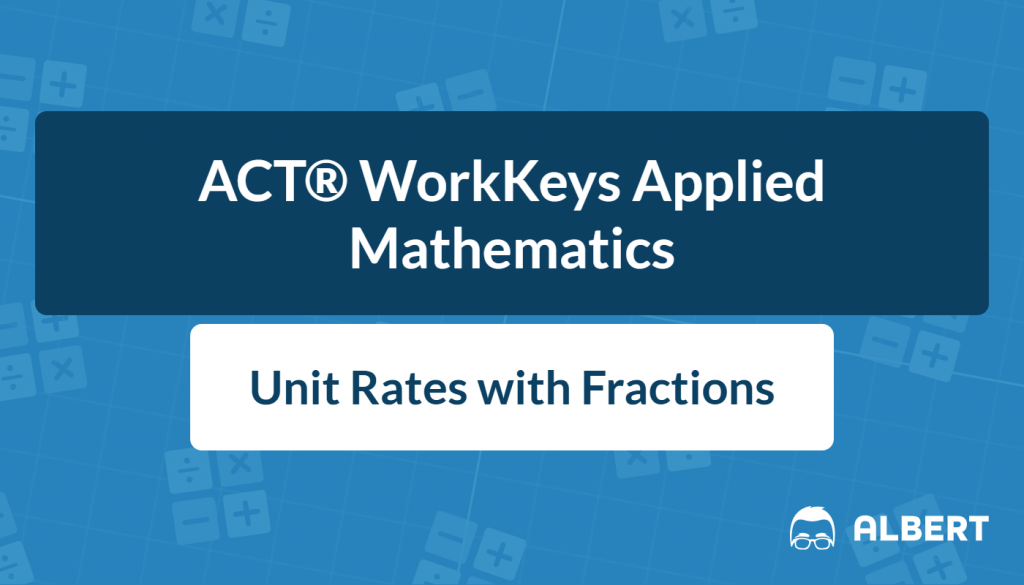Understanding unit rates with fractions is essential for mastering various math concepts, and it frequently appears in standardized tests such as the ACT® WorkKeys Applied Math Test. Unit rates with fractions play a vital role in our daily lives, aiding in the comprehension of speed (measured in miles or kilometers per hour) and production rates (reflecting output over time), as well as assisting in determining prices per ounce or per mile. This article aims to simplify the process of calculating unit rates with fractions through clear, step-by-step methods and applications.
What We Review
What is a Rate, and How Does it Differ from a Ratio?
A rate is a way to compare two different amounts that are measured in different units. Rates are often used to answer questions such as “How much?” or “How fast?” For instance, when we talk about driving 60 miles in one hour, we are expressing a rate. In this case, we refer to this as 60 miles per hour, which indicates how distance is being covered relative to time.
Conversely, a ratio is used to compare quantities measured in the same unit, illustrating their relationship. For example, if a recipe calls for 3 cups of flour and 2 cups of sugar, we can express this relationship as a ratio of 3:2. This ratio shows that for every 3 cups of flour, there are 2 cups of sugar in the recipe. Unlike rates, which involve different measurements, ratios focus solely on comparable units.
The Importance of Unit Rates with Fractions
Unit rates with fractions are useful because they enable us to compare various situations in a straightforward manner. For example, when we want to buy groceries, understanding the cost per item can help us determine which product offers the best value for money. Similarly, when assessing the fuel efficiency of a vehicle, knowing how many miles a car can travel per gallon of gas helps us gauge its performance.
Step-by-Step Guide to Calculate Unit Rates with Fractions
To calculate unit rates with fractions, follow these simple steps.
- Identify the given rate: This could refer to any quantity you can measure, like speed in miles per hour or how many items are made in a day.
- Express the rate as a fraction: Use fractions to represent the rate, such as ( \frac{3}{4} ) hours per task.
- Divide to find the unit rate: Divide the numerator (top number) by the denominator (bottom number). Simplify the fraction to express it as a “per one” unit rate.
Practicing these steps helps you become more confident and faster at solving unit rate problems. Being able to quickly change complex rates into simple ones makes it easier to deal with real-world situations.
Example: Calculating Production Rates
Imagine a factory that can make 90 items in 3.5 hours. To find out how many items it produces in one hour, we look at it as ( \frac{90\text{ items}}{3.5\text{ hours}} ).
Now, let’s simplify this. When you divide 90 by 3.5, you get about 25.7 items each hour.
This rate shows how well the factory is running.
Understanding these rates is useful for managers. If on another day, the factory produced 150 items in an 8-hour shift, its production rate was 18.75 items per hour. This is much less productive than 25.7 items per hour. If production consistently drops on certain days, it might indicate issues such as equipment malfunctions or insufficient staffing.
Practice Question: Production Scenario
You are a baker. Over the past 3 days, you have baked 120 loaves of bread. If you work 8 hours each day, how many loaves of bread do you bake per hour at your current baking rate?
Solution:
First, calculate the total number of hours you worked over the past 3 days:
3 \text{ days} \times 8 \text{ hours/day} = 24 \text{ hours}Next, to find the rate of loaves baked per hour, divide the total number of loaves by the total number of hours worked:
\frac{120 \text{ loaves}}{24 \text{ hours}} = 5 \text{ loaves/hour}Thus, at your current baking rate, you bake 5 loaves of bread per hour.
Understanding Speed as a Rate with Fractions
Speed is often expressed as a rate involving distance and time. It indicates how fast an object moves over a period. Fractions make it easier to represent these rates precisely.
Using fractions can simplify complex speed calculations. For instance, knowing the exact distance traveled per time unit is useful. Converting speeds into unit rates makes comparisons between different speeds more straightforward.
Example: Determining Speed Rates
A car travels 50 miles in 2.5 hours. To find the speed, we can express this as ( \frac{50\text{ miles}}{2.5\text{ hour}} ).
Now, let’s simplify the fraction by dividing 50 by 2.5.
When we divide 50 by 2.5, we get a speed of 20 miles per hour. This tells us how fast the car is going during the trip.
Practice Question: Speed Scenario
A cyclist covers 36 miles in 1.5 hours. What is the cyclist’s speed in miles per hour? Follow the steps to find the rate and verify the answer for accuracy.
To find the cyclist’s speed in miles per hour, we need the distance traveled and the time taken. The cyclist traveled 36 miles in 1.5 hours. We use the speed formula:
\text{Speed} = \frac{\text{Distance}}{\text{Time}}Substituting the values:
\text{Speed} = \frac{36 \text{ miles}}{1.5 \text{ hours}}Calculating this gives:
\frac{36}{1.5} = 24Thus, the cyclist’s speed is 24 miles per hour.
To confirm, we multiply the speed (24 mph) by the time (1.5 hours):
24 \text{ mph} \times 1.5 \text{ hours} = 36 \text{ miles}Since this matches the original distance, our calculation is correct. The cyclist’s speed is indeed 24 miles per hour.
Proportionality and Simplifying Fractions in Rates

Understanding proportionality is important when dealing with rates and fractions. Proportionality means that two ratios are equal, which indicates a constant relationship. This idea is essential for comparing different rates.
Simplifying fractions can make calculations simpler. When you reduce a fraction to its simplest form, it helps you understand the rate better. Simplified rates are also easier to compare with other rates.
For example, if you have a rate of ( \frac{12}{6} ), simplifying it to 2 is helpful. This means you have 2 items for each unit. This simplification makes it easier to grasp how the rate works.
Real-World Applications of Rates with Fractions
We often come across rates that include fractions in our daily lives. For example, when we cook, we use unit rates to determine how much of each ingredient we need. This includes measuring things like how many cups of flour to use for a recipe.
Another example is when we travel. When planning a trip, it’s important to know how many miles your vehicle can go on one gallon of gas. This miles-per-gallon information helps you manage travel costs and stick to your budget.
Tips for Solving Word Problems Involving Rates with Fractions
To solve word problems, it’s important to have a clear plan. Start by reading the problem carefully. Make sure you understand all parts of the situation. Look for key details and numbers before thinking of solutions. This step is crucial for effective problem-solving.
Here are some helpful tips:
- Check Units: Make sure all units in the problem match and make sense together. Different units can cause confusion, so it’s essential to ensure they align.
- Simplify Fractions: Always use simplified fractions when solving. This makes calculations clearer and easier to follow. Simplifying can make your work lighter and more straightforward.
- Double-Check: After you finish your calculations, review them. This helps catch mistakes and confirms that your answers are correct.
By following these steps and tips, you’ll find that even tough problems can be easier to manage. This will help you feel more confident in solving them.
Conclusion: The Relevance of Mastering Rates with Fractions
Grasping rates that involve fractions is an important skill useful in many everyday situations. These math skills help you solve different problems you might face and prepare you for more advanced math challenges later on. Knowing about rates is especially important for doing well on tests like the ACT® WorkKeys Applied Math Test and similar exams. By taking advantage of this learning opportunity, you can improve your math abilities and gain confidence in handling numbers and solving equations.
Sharpen Your Skills for ACT® WorkKeys Applied Math
Are you preparing for the ACT® WorkKeys Applied Math test? We’ve got you covered! Try our review articles designed to help you confidently tackle real-world math problems. You’ll find everything you need to succeed, from quick tips to detailed strategies. Start exploring now!
Need help preparing for the ACT® WorkKeys Applied Math Test?
Albert has hundreds of ACT® WorkKeys practice questions and full-length practice tests to try out.








